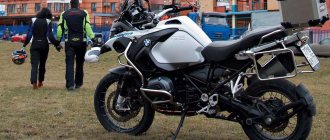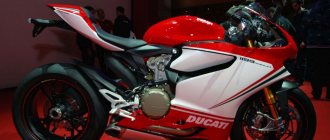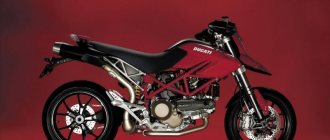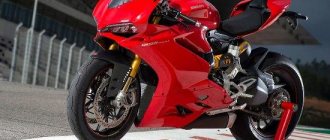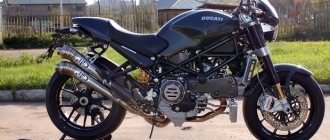Sometimes I go to have tea with my neighbor in the garage, and each time a certain ritual occurs: he asks me what motorcycle I was testing again, then asks how much it costs, widens his eyes and wonders if this motorcycle provides intimate services, for such and such a price?
My neighbor, of course, is still a frame, but it’s a worthwhile question nonetheless. When you buy a two-wheeled vehicle that costs the price of a two-room apartment in a metropolis, you expect it to be superior to some Izhak or scooter in everything, and not just cope with the same tasks. I was lucky enough to ride several really expensive motorcycles, but there were literally a couple of them that impressed me. Perhaps the Ducati Multistrada V4 S 2022 is one of them.
Ducati Multistrada V4 S 2021
History of the Ducati Multistrada
The history of the Ducati Multistrada goes back about 20 years. The first motorcycle of this family was launched from the stocks of the Bologna factory in 2001 in the form of a prototype, and in 2003 they were already firmly established in dealer showrooms. Back then it was a funny, long-legged sportbike - with long suspensions, a forked fairing reminiscent of some kind of fish or parrot, and ridiculous exhaust pipes coming out from under the seat, very reminiscent of jetpack nozzles from low-budget science fiction of the 90s. But in character it was a true Ducati, with a mighty 992 cc air-twin V-twin, on 17-inch wheels, with a single-sided swingarm that evoked nostalgia for the recently departed 998 sportsbike. Over time, the Multistrada evolved to a 1198 cc liquid-cooled engine (2010 ), then received the Skyhook semi-active suspension (2012), variable timing (2015), then in 2016 it spun off the Enduro twin on an evil 19-inch front tire, and by 2018 it grew to the 1260th version.
Ducati Multistrada V4 S 2022
For 2022, the Ducati Multistrada is updated again, this time with radar and the flagship V-four. But it wasn't just a transplanted V4 Stradale from a Panigale or Streetfighter: the new engine, called the V4 Granturismo, retained the reverse-rotating crankshaft and 53.5mm piston stroke of the Stradale, but the piston diameter was increased by 2mm to 83mm, and the cubic capacity increased accordingly to 1158cc An even more significant difference is Ducati's abandonment of the beloved desmodromic valve drive, which now has traditional springs. Other differences include smaller intake and exhaust valves, a lower redline speed (11,500 rpm) and a longer final gear (16/42) than the Streetfighter, which has a shorter first gear and a taller sixth gear.
The traditional spring valve drive is quite light, compact and efficient for this engine. Ducati says the V4 Grantourismo is just 2mm wider than the outgoing twin-cylinder 1260 engine, but 9.5cm lower, 8cm shorter and 1.2kg lighter than its predecessor. It is worth noting, however, that it is 2.2 kg heavier than the V4 Stradale. The fact that the engine is slightly smaller and lighter than the 1260 allowed the engineers to place it in the chassis so that the Multistrada V4's ground clearance has increased by 4.5 cm compared to the previous 1260 version (at the 19th front wheel). Also, the use of a traditional valve drive made it possible to increase the service interval of the Multistrada V4: the first major maintenance with valve adjustment is performed at 60 thousand, which is more than double that of the Multistrada 1260.
The 2022 Ducati Multistrada V4 S chassis updates were quite extensive, but their main goal was to improve comfort: a new shape for both seats and a worked out (finally!) issue with removing excess heat from the engine. The side radiators are blown through gill-shaped grilles, and behind the front wheel an air duct begins, exiting through a small hole behind the radiator just in front of the driver’s knee. It's definitely designed to provide airflow to the rider and dissipate engine heat while on the move. Also visible underneath the radiators are elements similar to aerodynamic wings, but designed to redirect fresh air to the rider's feet.
However, when I tested the Ducati Multistrada V4, it was not hot, so there was no problem with engine heat. I noticed that the coolant temperature was hovering around 70 degrees, which is quite unusual for most water engines, but the Ducati representative assured me that this was by design. By the way, the V4 Granturismo is equipped with the same technology as the V4 Stradale - turning off the rear pair of cylinders at idle to reduce heat generation. All these features say the same thing: the developers of the Ducati Multistrada V4 made sure that not only the engine, but also the rider was cool and comfortable on long hauls. Well, this time the designers did a really good and important job, but that's not all.
Ducati Multistrada V4 On the go
The Ducati Multistrada V4 is a big motorcycle. And not only in terms of working volume - it itself is voluminous and heavy (258 kg in running order), but despite this, the seat height of 84 cm does not seem so high when you sit in it. During the test ride, my colleague was riding next to me on another motorcycle, whose seat was 1.5 cm lower, but both of us, periodically switching motorcycles, noted that the seat on the Ducati was much more comfortable. In the touring class, seat height is a very ephemeral characteristic, especially in combination with an electronically adjustable suspension that can change height on the fly.
The controls, instrument panel and other ergonomics of the Multistrada V4 S 2022 are very reminiscent of the previous Multistrada - a wide, high steering wheel, a modest windshield, a nice dashboard. The tank and fairing are quite massive, and it feels like the bulk of the bike is in front of the rider, with the rider sitting in the bike rather than on it. Traditionally for today's realities, the digital TFT instrument panel shines with color menus and parameters and is controlled primarily by a five-way joystick and a few buttons on the left remote control. A nimble electric starter wakes up the engine, and it begins its uneven, guttural song, through which the ignition order is clearly audible, reminiscent of two-cylinder engines - the so-called “Twin-pulse”, traditional for the current V4 from Ducati.
Ducati Multistrada V4 S 2021
The 2022 Ducati Multistrada V4 S engine is incredibly calm and composed - even more so than the Streetfighter V4. Of course, as long as you don't provoke it, the bike is extremely friendly at low speeds, with a soft clutch and a precise transmission. Out of curiosity, I put it in third and left it chugging at idle, we drove about 30 km/h, and then I suddenly opened the gas. Despite the extremely unhealthy behavior of the rider, the motorcycle shuddered slightly and predictably rushed forward. I once had a second generation Multistrada - and if I tried to pull this trick on it, it would either stall or jerk so much that my teeth would loosen.
Otherwise, the ride on the 2022 V4 S is quite similar to previous Multistradas. The seating position is comfortable and high, the handling is light and precise - even more so than you would expect from such a large motorcycle. Riding along winding roads is incredibly fun, this motorcycle in every possible way emphasizes that it is only a joy for him. The BMW R 1250 GS or KTM 1290 Super Adventure S are also quite willing to waltz into corners, but the Multistrada really encourages active riding despite the 19-inch front wheel, and the rather narrow 170-gauge rear tire only helps with this. As for me, the V4 S 2021 is about as nimble as the 1260th version, which was slightly inferior in this quality to the previous Multistrada - in a word, not a sportbike, but quite a fun and nimble motorcycle.
Having turned into one corner a little faster than I should have, I held the rear brake pedal longer than usual - and as I leaned in, I felt the ABS pulsate under my right foot. A friendly reminder that while I'm having fun, the bike's computer is working.
In the best Ducati tradition, each riding mode cell (City, Touring, Sport, Enduro) can be further customized via the menu.
Engine power and response, traction control, ABS, wheelie control - they all have a range of settings, plus you can customize the quickshifter, daytime running lights and five options for the semi-active suspensions - fork and monoshock. You can also adjust the spring preload using a separate button on the left console, with four stages or an automatic leveling function that allows the bike to decide how much preload to add or subtract depending on the load.
Ducati Multistrada V4 S 2021
Going into that turn, I was driving in Touring mode. It's the softest response at full power, with traction control at stage five, ABS at stage three, eight clicks of preload, and mid-smooth positions for the fork and rear shock. In addition to adjusting the suspension on the fly, I used the quickshifter, the cornering lights worked out the leans, and the ABS stood by, ready to reduce pressure in the brake circuits if something went wrong. The only time the bike did anything weird or unsafe was when I hit a slippery patch of asphalt, the tire slipped, and the bike's computer tried to catch a grip in the dirt. Otherwise, the electronic motorcycle assistants have reached the level that the famous science fiction writer wrote about: “any sufficiently developed technology is indistinguishable from magic” - you just ride as if nothing had happened where you would have been scared for a long time or would have gotten away on a less equipped motorcycle.
Characteristics:
Frame Tubular space frame made of chrome-molybdenum steel
Wheelbase 1462 mm
Front fork angle 24°
Front suspension Fully adjustable Showa 43mm inverted fork
Front suspension travel 165 mm
Front brake 2 x 320 mm discs, 4-piston BREMBO calipers
Front wheel "3-spoke light alloy wheel 3.50 x 17
Front tire 120/70 ZR 17
Rear suspension Adjustable Showa monoshock absorber with progressive characteristics and hydraulic spring preload. Cantilever aluminum pendulum.
Rear suspension travel 133 mm
Rear brake 245 mm disc, 2-piston caliper
Rear wheel: 5-spoke alloy
Rear tire 180/55 ZR 17
Fuel tank volume 20 l. (including 6.5 l reserve)
Seat height 850 mm
Instrument panel Speedometer, tachometer, fuel level, emergency oil pressure indicator, high beam, turn indicators, neutral gear. Immobolizer. Watch
Color (Fairings-Frame-Wheels) (red-red-gray) (black-black-gray)
Number of seats Double
Type L-shaped 2-cylinder, 2 valves per cylinder, desmodromic valve timing, air cooling
Fuel tank capacity 992 cc
Bore x Stroke 94 x 71.5 mm
Power 67.7 kw - 92 hp @ 8000 rpm
Torque 9.4 kg/m @ 5000 rpm
Fuel injection system Marelli electronic injection system, intake manifold diameter 45 mm
Exhaust system Aluminum mono muffler
6 speed gearbox
Gear ratios “1st 37/15, 2nd 30/17, 3rd 27/20,
Primary drive "Straight-cut gears"
Main gear "Chain"
Clutch Dry multi-plate with hydraulic drive
A few years ago I was without two wheels for a week and a friend invited me to ride his Multistrada. I remember that motorcycle as the strangest one I had ever ridden. In particular, I did not understand how it was possible to produce a bike with such wooden controls.
Therefore, I accepted the opportunity to test a similar device without much enthusiasm. Although the desire to understand this Ducati of the mid-2000s has not disappeared. In addition, the owner of the motorcycle and, concurrently, the main “ducat driver” of the country, Maxim, chose the Multistrada as his motorcycle No. 1. Although at different times he had a lot of European streets and sports. I felt that I simply had to make an attempt to become friends with this motorcycle.
For a person who rides a Ducati for the first time (especially early models), every little detail is strikingly different from the “Japanese”. For example, to start a motorcycle, you need to press and release the starter button without holding it down until the engine starts. The sound of the big air suspension and the vibrations of the motorcycle first frighten you, then fascinate you. The Ducati lettering truly has magical properties. Even a seasoned motorcyclist gets butterflies in his stomach from such a bike.
Thanks to a neat and technologically advanced instrument panel with a large LCD screen, elaborately shaped mirrors and characteristic chopped lines of the tank, the motorcycle looks very fresh from the rider’s position. If you look at it from the side, the front fairing has a very ambiguous shape. In the Bolognese “design report card”, the Multistrada clearly herds the rear.
The visual lightness of the motorcycle’s design is surprising: a lot of “air” above both wheels, mufflers located under the tail, a narrow engine housing and an unobtrusive steel frame cage. The compact arrangement of parts was achieved, among other things, due to some extraordinary technical solutions. Thus, fuel splashes not only in front of the pilot, but also under both seats: the cunningly shaped tank stretches from the tip of the motorcycle’s tail to the steering column.
Ducati Multistrada V4 S off-road
Riding the new Ducati Multistrada V4 S off-road is an enjoyable and impressive experience, punctuated by small bursts of panic. Overall, the motorcycle is balanced and handles well, plus the clarity of the clutch modulation and smooth engine operation make it easy to sneak where you can’t go straight ahead. Jumping on the Multistrada V4 best reveals the benefits of the semi-active suspension. It's really cool to feel the bike tighten up as the suspension folds, absorbing the energy of the jump. But as soon as you exceed your capabilities, not only the weight of the motorcycle will fall on you, but also the unaffordable bill for its repairs - 260 kg and 25 thousand dollars are somehow not conducive to risky riding.
So, as an SUV, the Ducati Multistrada V4 S 2021 is not bad, but only as a last resort, and if you are prepared for the fact that a motorcycle that has helped you out more than once may try to kill you by being too heavy or too powerful, depending on the circumstances. As a touring bike, the Multistrada V4 S is excellent - except for one glaring issue, which is range.
Ducati Multistrada V4 S 2021
Firstly, the V4 is power hungry. I got from 6 to 8 liters per hundred, which means that a 22 liter tank in theory should be enough for about 300 kilometers. In reality, the beggar lights up a little after two hundred, and it is advisable to find a gas station after 50 kilometers. Once I was on the verge of drying out, judging by the range reading (in his opinion, I had 3 kilometers left) - and only 20 liters fit into the tank. It's all strange.
If this didn’t seem critical to you, I’m happy for you, because the rest of the motorcycle is great. The seat is quite different from the previous version, it is narrower at the back, and the passenger area has thicker padding. My passenger praised the comfortable footrests and heated seat. Wind protection is quite good, and Ducati has somehow managed to improve the adjustment of the windshield - now by moving a peg on the dashboard back and forth, the windshield easily rises and lowers and is securely locked in place.
Down with traffic jams
As soon as I turned from the garage cooperative onto the main street, I realized that the previous time I had come across some kind of wrong motorcycle, either in emergency condition, or simply in need of chassis repair. It turns out that the Multistrada handles excellently: it maneuvers smoothly and predictably at low speeds, and confidently and obediently makes arcs in fast turns. Now I recognize the Ducati and feel like I'm going to have two wonderful days with this bike.
The gentle “pincers” of morning traffic jams tightened around the still sleepy, but already nervous drivers. I began to carefully squeeze into the aisles and maneuver between cars, getting used to the dimensions, brakes and gearbox of the motorcycle. By the end of the day, having covered almost a hundred kilometers throughout the city, I was able to weave through traffic jams with ease of thought, easily climbed curbs and, playfully, jumped off them where cars had “bricked up” everything tightly.
Radar and cruise control Ducati Multistrada V4 S 2022
On a good road the bike with its warm grips and heated seat is excellent, the engine is elastic, the suspension is wonderful. And it all got even better when Ducati decided to put radar on it. A Bosch-developed radar module is installed at the front of the motorcycle and another at the rear, and thanks to these modules, the Multistrada V4 now has adaptive cruise control with collision mitigation and a blind spot warning system. I won't go into too much detail about how it all works, there's already information on the site about how it all works and I don't have much to add to that text.
In practice, adaptive cruise control is just a blast! When approaching a slower vehicle, the motorcycle calculates its speed and reduces its own.
I experimented with ACC on the highway, where the system politely sat on the tail of cars and kept a set distance (with the ability to choose one of four options). I ended up approaching cars too fast and got the cruise control to apply the brakes. I cannot estimate exactly how much braking force was used - but not small, I think that it was 60 percent of the maximum without any intervention from me. Pretty scary, by the way. And in the end I set 85 km/h on a winding road and followed a truck going 50 - the motorcycle just rolled smoothly in its tail, not at all surprised, until I decided to stop on the side of the road, squeezed the brakes - and the cruise control turned off, blinking goodbye with a light bulb.
Ducati Multistrada V4 S 2021
At first I thought that there was no point in switching when the cruise control was on - it turned out to be nothing like that. When the motorcycle slows down strongly in front of a slower vehicle, you shift down and the engine goes to a more comfortable speed. If I change into a faster lane, the bike accelerates on the open road, realizing we are ahead of the car, and I shift up if necessary. As they explained to me, the motorcycle determines whether the adjacent lane is clear, even though it is behind the car. If you change lanes without checking if there is someone behind you, a strip of orange lights at the top of the mirror will light up, and when the turn signals are on, the same strip will blink.
This is how the motorcycle tells you that there is something in the blind spot between the mirror's line of sight and the line of peripheral vision. This technology has long been implemented in many cars, but its motorcycle implementation turned out to be quite tricky. Cars don't tilt, unlike motorcycles, so I suspected that tilting the mirror would tell me that the motorcycle was 'sensing' stones on the side of the road - but no, the system completely ignores them, and even tracks the speed at which cars are driving in the blind zone. The system ignored those that I quickly overtook, but when someone was sneaking up or driving close to my speed, the rear radar reminded me of those.
A little off-road
Strictly speaking, the Multistrada is not intended for off-road use.
The Italians most likely intended to take it to rural roads in Europe - it is unlikely that they would drive their creation onto the bumpy dirt roads of fields. And it’s painful to watch how dust and dirt cover the glamorous black plastic of the Ducati. And we went to field testing in the literal sense of the word. Fortunately, the weather was dry, and even purely road touring tires did not prevent us from appreciating the Ducati's enduropean capabilities.
At different times, under similar conditions, I tested the most popular enduro-tourers in our area, the BMW R1200GS and the KTM 990 Adventure. I must say that, despite the shorter suspension travel, the Multistrada is not only not inferior to this pair, but also wins due to the difference in weight and its distribution.
The Ducati is very comfortable to ride while standing on the pegs, any jumps are easy and, most importantly, the bike is as easy to control as on the asphalt. And the L-shaped engine pulls just right at low speeds. If you put the bike on dual-purpose tires, you can ride it without any regard for the quality of the roads. Of course, 17-inch alloy wheels impose a certain limitation, but when operated at reasonable, and especially legal, speeds, this will not in any way affect the capabilities of the Multistrada.
Of course, the noble Italian is more accustomed to the role of a road tourist. For this purpose, Ducati has a high windshield, the ability to attach side cases and remote adjustment of the spring preload of the rear monoshock absorber. In addition, the gearbox is configured accordingly: the fifth and sixth gears are high. Add a comfortable suspension with increased travel and you get the right motorcycle for roads of varying quality.
What else?
But that, as they say in advertising, is not all. Ducati has partnered with navigation software and technology company Sygic to combine the Ducati Connect app with Sygic's navigation system. The result was twofold: having installed both applications and connecting the phone to the dashboard via a wireless protocol, I made sure that the programs recognized each other, then selected the desired mode in one of them, and then connected the phone to the motorcycle. Not for data transfer, but simply to prevent the phone screen from going dark, because all this only works if the phone is not locked. Fortunately, the motorcycle has a convenient glove compartment with a USB socket just for this case.
When everything worked as it should, the three-dimensional navigation pleased me - it works smoothly, without jerks, the prompts are clear and correct, and plus the navigator receives online data about traffic jams, displaying them in the route status bar. Unfortunately, after 40 kilometers the navigation froze and I couldn’t even return the dashboard to normal mode until I turned off the ignition. I turned off Sygic syncing and just connected my phone and helmet headset to the bike, which is no worse. Using the joystick on the steering wheel, I can control the playlist, and on the dashboard screen I can see who is calling me. But there are some shortcomings here too - the sound, for example, by default is transmitted not to the headset, but to the motorcycle, which, for a moment, does not have speakers, and during a call the tidy freezes and is not updated - I think this is a particularly big disadvantage when using a navigator.
In short, the dashboard is too universal, but unfinished - this is a significant minus. While you are fiddling with it, you have a non-zero chance of missing something and falling, and as a result, it is better to use navigation and music simply using the intercom in the helmet. No matter how inconvenient their interface may be, it is better than being distracted by the incorrect operation of the dashboard. All I can do is simply praise the radar system for its bug-free operation, and note that multimedia devices are the same as computers or smartphones, and crooked software can negate all their possible advantages.
Owner's opinion
There should be a lot of motorcycles, for all occasions. But when you need one universal bike, you have to look for a compromise. Of all the many two-wheelers that have been in my hands, I chose the Multistrada for constant driving. Proper weight distribution, fairly long-travel, fully adjustable suspension, tenacious Bremo brakes with reinforced lines, plus a straight and comfortable landing, multiplied by a narrow silhouette and a wide steering angle, make it easy to nimble in city traffic, not paying attention to broken asphalt, low curbs and speed bumps.
By changing the suspension settings, you can lean the bike into turns or, conversely, grab a broken grader. The main limiter here is the tires. The power of a liter pole is enough for fast movement in space, although speeds well over 200 are not the Multistrada’s strong point. Good traction from the bottom allows you to ride confidently with or without a passenger. The bike is also suitable for country voyages: a 20-liter tank, good wind protection, and even an electric headlight leveler.
During the entire period of operation, “Multik” has never let me down and gives me a lot of pleasure. It’s not for nothing that when designing the Hypermotard, Ducati took the Multistrad as a basis.
About prices for Ducati Multistrada V4 S 2022
The basic version of the Ducati Multistrada V4 is priced at $20,000 on the American market. This variant comes with a smaller TFT instrument cluster, smaller brake discs, conventional suspension, halogen headlights and no radar. The Ducati Multistrada V4 S variants are equipped with a radar as standard, but for example in the American market this radar is still blocked, because its use is not currently homologated by the US government. To unlock it, the owner will have to contact a Ducati dealer, and this operation will be paid and will cost a solid $850 on top of the price of the S model, which, for example, in the Travel configuration (saddlebags, heated seats and handles, center stand, radar) on tubeless spoked tires costs $24,700 .



